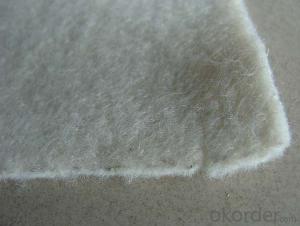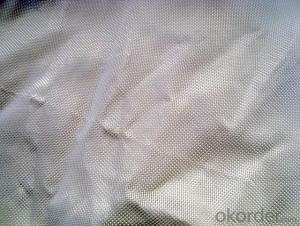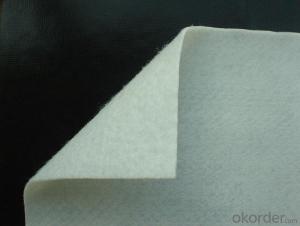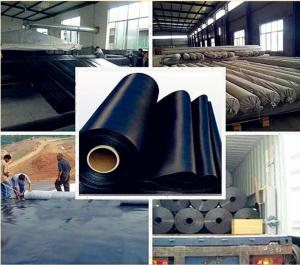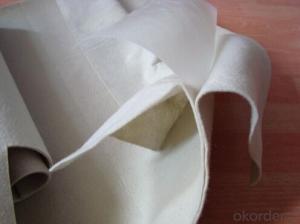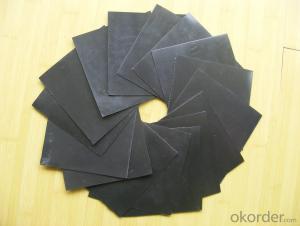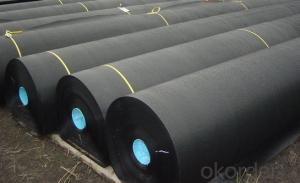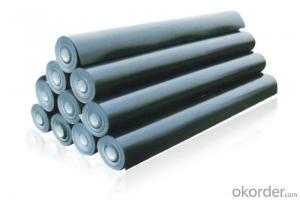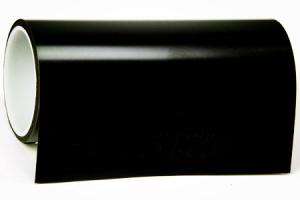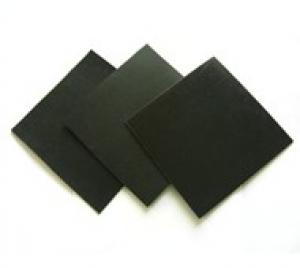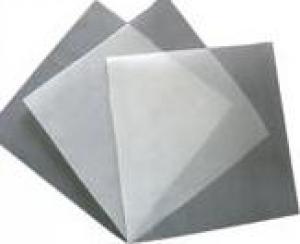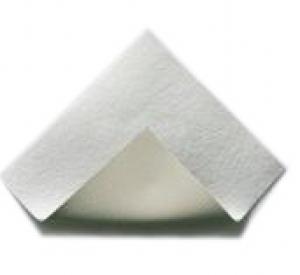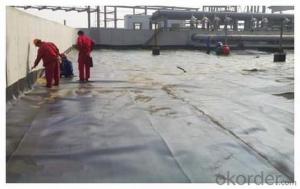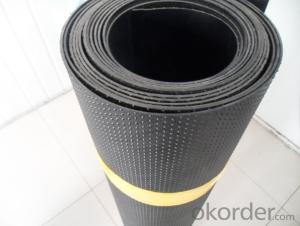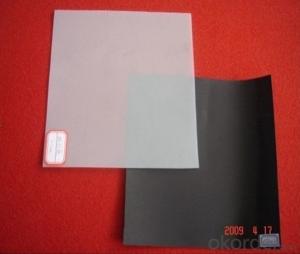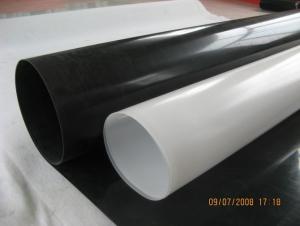Waterproof Membrane Roll for all Types of Ponds
- Loading Port:
- China main port
- Payment Terms:
- TT OR LC
- Min Order Qty:
- 1000 m²
- Supply Capability:
- 1000000 m²/month
OKorder Service Pledge
OKorder Financial Service
You Might Also Like
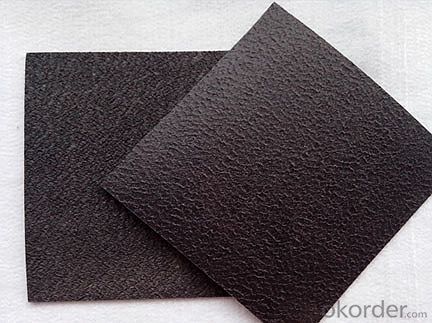
Classified by Material
1. HDPE Geomembrane
2. LDPE Geomembrane
3. LLDPE Geomembrane
Function: Waterproof
Application:
Water conservancy projects
Landfill treatment projects
Mineral waterproofing
Agricultural waterproofing
Color:Black or at your request
Density: 0.94g /cm3
Temperature range: -60oC -- +60oC
Life time: more than 50 years
Executive standard: GB/T 17643-2011
Features: Excellent environment stress resistant cracking performance and chemical erosion resistance.
Big scope of application temperature and long service life.
Our Service
1.On a regular basis or as per your request,we entrust national testing agencies to conduct quality inspections
2. Strictly in accordance with the ISO9001-2008 international quality system standard,we monitor and manage the whole process throughout production,quality testing,and measurement to ensure product quality
3. For quality-related construction delay or substandard construction(except for damage or losses due to customer’s responsibility or irresistible natural disasters),we have refunding,replacement,and repair services.We will respond to customers’ feedbacks on quality issues within 24 hours.
FAQ:
Q: What kind of payments does jenor support?
A: T/T, L/C, Cash are accepted.
Q: Do you charge for the samples?
A: Accordeing to our company policy, the samples are free, we only charge the freight fee. And we will return the freight fee during the next order.
Q: Can you produce according to customers' design?
A: Sure, we are professional manufacturer, OEM and ODM are both welcome.
Q: Do you have other products?
A: Yes, please check the pictures:
- Q:What are the limitations of geomembranes in seismic-prone areas?
- Geomembranes, while effective for various applications, have certain limitations in seismic-prone areas. One major limitation is their susceptibility to damage or failure during earthquakes due to the high levels of ground shaking. The intense ground motion can cause the geomembranes to tear, rupture, or develop leaks, compromising their ability to contain liquids or gases. Additionally, the lateral displacement and ground settlement associated with seismic events can lead to the distortion or misalignment of geomembrane liners, reducing their effectiveness as a barrier. Therefore, in seismic-prone areas, it is crucial to consider these limitations and implement additional measures, such as improved anchoring systems or reinforced designs, to enhance the seismic resilience of geomembranes.
- Q:Which is better for geomembrane hot melting in the middle of sliding layer of high-speed railway bridge two cloth and one membrane, lapping or docking? And what is the lapping length if it is lapping hot melting?
- In general, it should not be cut according to graphic size. Shorten joint length and strain as far as possible. After geomembrane pavement, the lap?width between films should be not less than 10 cm. 4. Usually set at a corner and abnormal section. 6, arrange along the gradient direction and avoid accidental damage to membrane when the temperature is low. Lap width between membranes is generally not less than 10 cm. You should measure the accurate relative size. Do not weld as far as possible during geomembrane pavement . In addition to the special requirements, Do not walk on the membrane or carry on the membrane.
- Q:What materials does geomembrane belong to?
- The geomembrane is a kind of geosynthetics, including the geotextile, geogrid, geogrid, and so on. The geosynthetics is made of polyethylene, polypropylene, polyester and other plastic materials. The main function of the geotechnical membrane is seepage-proof, that is to say, preventing water from penetrating through. The most important material is polyethylene, other types are less in the total number, including PVC, EVA, EPDM.
- Q:Does anyone know the mechanism of ion exchange membrane
- the mechanism are as follows: Ion exchange resins are high molecular material with an ion exchange function. in the solution, the ion of itself will have an exchange with the ion which has the same symbol in the solution. According to the different nature of the exchange groups, the ion exchange resin can be divided into cation exchange resin and an anion exchange resin. Most of the cation exchange resin has a sulfonic acid group (-SO3H), carboxyl (-COOH) and phenol (-C6H4OH) and other acidic group, wherein the hydrogen ions in solution can have an exchange with a metal or other cation. For example, the polymers of styrene and divinylbenzene by sulfonation is giving strong acid cation exchange resin and the structure can be simply expressed as R-SO3H, wherein R represents a resin matrix, the exchange mechanism is 2R-SO3H + Ca2 + (R-SO3 ) 2Ca + 2H this is the mechanism of water softening. Anion exchange resin comprises quaternary amine [-N (CH3) 3OH], amino (-NH2 ) or imidogen (-NH2 ) and other alkaline group. They can generate OH- ions in the water, and have exchange interaction with a variety of anions, the exchange mechanism is R-N (CH3) 3OH + Cl- R-N (CH3) 3Cl + OH- due to the ion exchange is reversible, so the used ion exchange resin is suitable to wash with acid or base resin with a suitable ion exchange concentration, to restore the original state and repeated use, so the process is called regeneration. cation exchange resin can be washed with dilute hydrochloric acid, dilute sulfuric acid solution; the anion exchange resin can be treated with sodium hydroxide solution, etc., and then reproduced. ion exchange resins are widely used, and it is mainly for the isolation and refinement. For example, softening water system and producing deionized water, recycling metal in industrial wastewater, separating rare metals and precious metals separation and purification of antibiotics.
- Q:Can geomembranes be used for irrigation canals?
- Yes, geomembranes can be used for irrigation canals. Geomembranes are impermeable liners that can effectively control seepage and prevent water leakage. By installing geomembranes in irrigation canals, it helps to conserve water resources, reduce evaporation, and ensure more efficient and effective water distribution for agricultural purposes.
- Q:What are the differences of seepage-proof geomembrane and polypropylene fiber impervious geotextile?
- The seepage-proof geomembrane is made of high density polyethylene by flat extrusion or blow molding. The white seepage-proof geomembrane is heated and covered with polypropylene fiber geotextile top and bottom which finally becomes polypropylene fiber impervious geotextile. It has a good extensibility and environmental resistance as well as better anti-seepage effect. The seepage-proof geomembrane is usually black or white HDPE.
- Q:What are the advantages of using geomembranes in mining tailings ponds?
- Using geomembranes in mining tailings ponds offers several advantages. Firstly, geomembranes act as a barrier between the tailings and the surrounding environment, preventing the contamination of soil and water sources with toxic chemicals and heavy metals. This helps in safeguarding the ecosystem and protecting human health. Additionally, geomembranes reduce seepage of water from the tailings, minimizing water loss and allowing for efficient water management. They also improve the stability and integrity of the tailings pond, preventing slope failures and ensuring long-term structural integrity. Overall, the use of geomembranes in mining tailings ponds enhances environmental sustainability, reduces risks associated with tailings storage, and promotes responsible mining practices.
- Q:does Landfill reservoir area include the part that is buried in the anchorage ?
- it doesn't include the area in retractable and anchoring area. the actual coverage area does not contain a linker.
- Q:What are the differences of geocells and geogrids?
- Geocells have three-dimensional celllike structure made from reinforced HDPE sheets by strength welding. They are usually made by ultrasonic pin type welding. Sometimes there are holes punched on the membranes for the requirements of engineering. They are elastic and shrinkable when transported. They can be stretched into shape of net. When geogrids are filled with bulky material like soil, rubble and concrete, a structure with high sidewise restraint and high rigidity forms. They have light weight, good wear resistance, chemical stability, photooxidation resistance, aging resistance, acid resistance and alkali resistance. They can be used in different soil conditions like soil and desert. They can be used to reinforce the roadbeds of highways and railways. They can be used to protect slopes and construct mixed barricades. Geogrids are 2D latticed grids or three-dimensional screen grids made from high-molecular polymers like polypropylene and PVC (polyvinyl chloride) by thermoforming or mould pressing. They are applied in the field of civil engineering. Geogrids are often used as tendon material of reinforced soil structure or of other composite materials. Geogrids can be divided into four categories, namely plastic geogrid, steel geogrid, glass fiber geogrid and polyester warp knitting dacron geogrid. Geogrids are used to reinforce all kinds of dams, roadbeds, side slopes, tunnel walls, and permanent bases of large airports, parking lots, wharfs, freight yards, etc. Geogrids are easy to install. They are time saving, labor saving with shorter construction time and lower maintenance cost.
- Q:How do geomembranes handle soil erosion?
- Geomembranes are used as a barrier to prevent soil erosion by providing a durable and impermeable layer. They are designed to withstand the erosive forces of water, wind, and other environmental factors, thereby protecting the soil beneath from being washed away or displaced. Additionally, geomembranes can be anchored or secured in place to further enhance their effectiveness in preventing soil erosion.
1. Manufacturer Overview |
|
|---|---|
| Location | |
| Year Established | |
| Annual Output Value | |
| Main Markets | |
| Company Certifications | |
2. Manufacturer Certificates |
|
|---|---|
| a) Certification Name | |
| Range | |
| Reference | |
| Validity Period | |
3. Manufacturer Capability |
|
|---|---|
| a)Trade Capacity | |
| Nearest Port | |
| Export Percentage | |
| No.of Employees in Trade Department | |
| Language Spoken: | |
| b)Factory Information | |
| Factory Size: | |
| No. of Production Lines | |
| Contract Manufacturing | |
| Product Price Range | |
Send your message to us
Waterproof Membrane Roll for all Types of Ponds
- Loading Port:
- China main port
- Payment Terms:
- TT OR LC
- Min Order Qty:
- 1000 m²
- Supply Capability:
- 1000000 m²/month
OKorder Service Pledge
OKorder Financial Service
Similar products
New products
Hot products
Hot Searches
Related keywords
